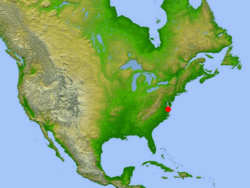Top Qs
Timeline
Chat
Perspective
Chesapeake Bay impact crater
Impact crater in the Eastern United States From Wikipedia, the free encyclopedia
Remove ads
The Chesapeake Bay impact crater is a buried impact crater, located beneath the mouth of the Chesapeake Bay, United States. It was formed by a bolide that struck the eastern shore of North America about 35.5 ± 0.3 million years ago, in the late Eocene epoch. It is one of the best-preserved "wet-target" impact craters in the world.[3]
Continued slumping of sediments over the rubble of the crater has helped shape the Chesapeake Bay.
Remove ads
Formation and aftermath
Summarize
Perspective
During the warm late Eocene, sea levels were high, and the tidewater region of Virginia lay in the coastal shallows. The shore of eastern North America, around where Richmond, Virginia is today, was covered with thick tropical rainforest, and the waters of the gently sloping continental shelf were rich with marine life that was depositing dense layers of lime from their microscopic shells.[citation needed]
The bolide made impact at a speed of approximately 17.8 kilometers per second (11.1 miles per second),[4] punching a deep hole through the sediments and into the granite continental basement rock. The bolide itself was completely vaporized, fracturing the basement rock to depths of 8 km (5 mi), and raising a peak ring around it. The deep crater, 38 km (24 mi) across, is surrounded by a flat-floored terrace-like ring trough with an outer edge of collapsed blocks forming ring faults.[citation needed]
The entire circular crater is about 85 km (53 mi) in diameter and 1.3 km (1,300 m; 0.81 mi; 4,300 ft) deep, an area twice the size of Rhode Island, and nearly as deep as the Grand Canyon. However, numerical modeling techniques by Collins et al. indicate that the post-impact diameter was likely to have been around 40 km (25 mi), rather than the observed 85 km (53 mi).[4]
The surrounding region suffered massive devastation. USGS scientist David Powars, one of the impact crater's discoverers, described the immediate aftermath: "Within minutes, millions of tons of water, sediment, and shattered rock were cast high into the atmosphere for hundreds of miles along the East Coast." An enormous megatsunami engulfed the land and possibly even reached the Blue Ridge Mountains.[5] The sedimentary walls of the crater progressively slumped in, widened the crater, and formed a layer of huge blocks on the floor of the ring-like trough. The slump blocks were then covered with the rubble or breccia. The entire bolide event, from initial impact to the termination of breccia deposition, lasted only a few hours or days. In the perspective of geological time, the 1.2 km (0.75 mi) breccia was an instantaneous deposit. The crater was then buried by additional sedimentary beds that have accumulated during the 35 million years following the impact.[citation needed]
The impact has been identified as the source of the North American tektite field, namely the Georgiaite and Bediasite fields.[6]
Remove ads
Discovery

It was not until 1983 that evidence of a large impact crater was found, buried beneath the lower part of the Chesapeake Bay and its surrounding peninsulas. The first hint was an 8-inch-thick (20 cm) layer of ejecta found in a drilling core taken off Atlantic City, New Jersey, about 170 miles (274 km) to the north. The layer contained the fused glass beads called tektites and shocked quartz grains that are unmistakable signs of a bolide impact.
In 1993, data from oil exploration revealed the extent of the crater.[7]
Remove ads
Effects on local rivers
The continual slumping of the rubble within the crater has affected the flow of the rivers and shaped the Chesapeake Bay. The impact crater created a long-lasting topographic depression that helped predetermine the course of local rivers and the eventual location of the Chesapeake Bay. Most important for present-day inhabitants of the area, the impact disrupted aquifers. The present freshwater aquifers lie above a deep salty brine, remnants of 100- to 145-million-year-old Early Cretaceous North Atlantic seawater, making the entire lower Chesapeake Bay area susceptible to groundwater contamination.[8]
See also
- Toms Canyon structure probable impact crater 322 km (200 mi) to the northeast.
- Popigai impact structure of similar age
- Grande Coupure
- Carolina bays
References
Bibliography
External links
Wikiwand - on
Seamless Wikipedia browsing. On steroids.
Remove ads



